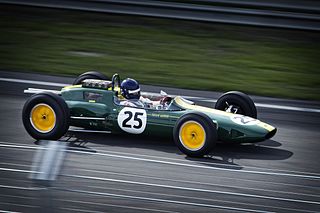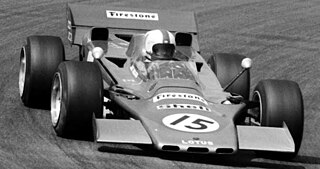
James Clark Jr. OBE was a British Formula One racing driver from Scotland, who won two World Championships, in 1963 and 1965. A versatile driver, he competed in sports cars, touring cars and in the Indianapolis 500, which he won in 1965. He was particularly associated with the Lotus marque.

The 1968 Formula One season was the 22nd season of the FIA's Formula One motor racing. It featured the 19th FIA World Championship, which commenced on 1 January, and ended on 3 November after twelve races, and numerous non-championship races. Graham Hill won the second of his World Championship titles, with Lotus.
Michael Henderson Spence was a British racing driver from England. He participated in 37 Formula One World Championship Grands Prix, debuting on 8 September 1963. He achieved one podium, and scored a total of 27 championship points. He also participated in numerous non-Championship Formula One races, as well as sports car racing.
Team Lotus was the motorsport sister company of English sports car manufacturer Lotus Cars. The team ran cars in many motorsport categories including Formula One, Formula Two, Formula Ford, Formula Junior, IndyCar, and sports car racing. More than ten years after its last race, Team Lotus remained one of the most successful racing teams of all time, winning seven Formula One Constructors' titles, six Drivers' Championships, and the Indianapolis 500 in the United States between 1962 and 1978. Under the direction of founder and chief designer Colin Chapman, Lotus was responsible for many innovative and experimental developments in critical motorsport, in both technical and commercial arenas.

The Lotus 48 was a Formula 2 racing car designed by Colin Chapman and Maurice Phillippe and powered by a 1,600 cc (98 cu in) Cosworth FVA engine. It won three races in the hands of Jim Clark but was generally uncompetitive against rival machinery. Ultimately, its main claim to fame is as the car in which Clark was killed at Hockenheim on 7 April 1968.

The Lotus 25 was a racing car designed by Colin Chapman for the 1962 Formula One season. It was a revolutionary design, the first fully stressed monocoque chassis to appear in Formula One. In the hands of Jim Clark it took 14 World Championship Grand Prix wins and propelled him to his 1963 World Championship title. Its last World Championship win was at the 1965 French Grand Prix.

The Lotus 49 was a Formula One racing car designed by Colin Chapman and Maurice Philippe for the 1967 F1 season. It was designed around the Cosworth DFV engine that would power most of the Formula One grid through the 1970s. It was one of the first F1 cars to use a stressed member engine combined with a monocoque to reduce weight, with other teams adopting the concept after its success. It also pioneered the use of aerofoils to generate downforce.

The Lotus 33 was a Formula One car designed by Colin Chapman and Len Terry and built by Team Lotus. A development of the successful Lotus 25, in the hands of Jim Clark it won five World Championship Grands Prix in 1965, taking Clark to his second World Championship.

The Lotus 18 was a race car designed by Colin Chapman for use by Lotus in Formula Junior, Formula Two, and Formula One.

The Lotus 56 was a gas turbine-powered four-wheel-driven racing car, designed by Maurice Philippe as Team Lotus's STP-backed entry in the 1968 Indianapolis 500. All three cars entered retired from the race, Joe Leonard's car expiring while leading just eight laps from the finish.

The Lotus 23 was designed by Colin Chapman as a small-displacement sports racing car. Nominally a two-seater, it was purpose-built for FIA Group 4 racing in 1962–1963. Unlike its predecessors Lotus 15 and 17, the engine was mounted amidship behind the driver in the similar configuration developed on Lotus 19.

The Lotus 22 was a racing car built by Lotus cars in 1962, and a total of 77 cars were built. It was developed from the 1962 Lotus 20, with the major differences that it had disc brakes all round, a top link and the 'rubber donut' to the rear suspension and a dry sump engine that was canted over to lower the centre of gravity. Also notable is the smoother bodywork covering the engine, compared to the boxy design of the 20.

The Brabham BT19 is a Formula One racing car designed by Ron Tauranac for the British Brabham team. The BT19 competed in the 1966 and 1967 Formula One World Championships and was used by Australian driver Jack Brabham to win his third World Championship in 1966. The BT19, which Brabham referred to as his "Old Nail", was the first car bearing its driver's name to win a World Championship race.
Four-wheel drive (4WD) has only been tried a handful of times in Formula One. In the World Championship era since 1950, only eight such cars are known to have been built.

The BRM P261, also known as the BRM P61 Mark II, is a Formula One motor racing car, designed and built by the British Racing Motors team in Bourne, Lincolnshire, England. The BRM P261 was introduced for the 1964 Formula One season, and its design was an evolution of Tony Rudd's one-off BRM P61 car of 1963. The P261 had a relatively long racing career; variants of the car were still being entered for Formula One World Championship Grands Prix as late as 1968. During the course of their front-line career BRM P261s won six World Championship races, in the hands of works drivers Graham Hill and Jackie Stewart, and finished second in both the Drivers' and Constructors' Championship standings in 1964 and 1965. Stewart, Hill and Richard Attwood also used works P261s to compete in the Tasman Series in 1966. The BRMs dominated, with Stewart winning four, Hill two, and Attwood one of the 1966 Tasman Series' eight races. Stewart also won the title. The works-backed Reg Parnell Racing team returned in 1967 with Stewart and Attwood, where Stewart added another two wins to his tally. In terms of races won and total Championship points scored, the P261 was the most successful car in BRM's history.

The Honda RA271 was Honda's second Formula One racing car, and its first to actually enter a race. The chief engineer on the project was Yoshio Nakamura, with Tadashi Kume in charge of engine development. It was driven in three races during 1964 by American driver Ronnie Bucknum.

The Brabham BT3 is a Formula One racing car. It was the first Formula One design to be produced by Motor Racing Developments for the Brabham Racing Organisation, and debuted at the 1962 German Grand Prix. The Brabham BT3 was the vehicle with which team owner – then two-time World Champion – Jack Brabham, became the first driver ever to score World Championship points in a car bearing his own name, at the 1962 United States Grand Prix. The following year Brabham also became the first driver ever to win a Formula One race at the wheel of an eponymous car, again driving the BT3, at the 1963 Solitude Grand Prix. The BT3 design was modified only slightly to form the Tasman Series-specification Brabham BT4 cars.

The March 701 is a Formula One racing car model, designed by Robin Herd with Peter Wright, and built by March Engineering. The 701 was March's first Formula One design – following their one-off March 693P Formula Three prototype of 1969 – and was designed and built in only three months. The March 701 made its race debut a month after its public unveiling, at the 1970 South African Grand Prix. In total, eleven 701s were constructed, with March supplying many privateer entrants as well as their own works team. The 701's career started well, March drivers taking three wins and three pole positions from the car's first four race entries, but lack of development through the 1970 Formula One season resulted in increasingly poor results as the year wore on. The 701 was superseded by the March 711 in 1971, and made its last World Championship race appearance at the 1971 Italian Grand Prix.

The Lotus 35 was a multi-formula racing car designed by Colin Chapman and powered by a variety of engines. In the hands of Jim Clark it won five Formula Two races in 1965 and enabled Clark to win the 1965 Trophées de France Championship and the 1965 British Formula Two Championship.

The BRM P83 was a Formula One racing car designed by Tony Rudd and built by British Racing Motors for the new engine regulations of 1966. It used a highly unorthodox H16 engine which caused problems throughout the car's racing life, and despite the best efforts of Graham Hill and Jackie Stewart took BRM from championship contenders to also-rans, leading it to be regarded alongside the BRM Type 15 as another embarrassing failure for the British marque caused by overcomplicated engineering.


















